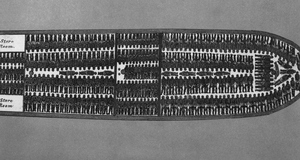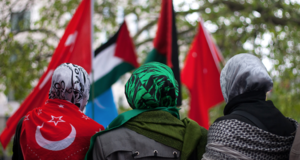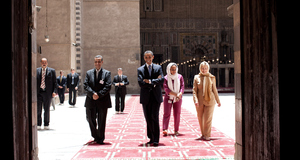Occupation and the Road Not Traveled in Habibi Rasak Kharban (2011)
By
2022, Vol. 14 No. 09 | pg. 1/1
IN THIS ARTICLE
KEYWORDS
AbstractIn adapting the twelfth-century story Layla and Majnun, Susan Youssef’s 2011 film Habibi Rasak Kharban re-imagines the Arabic folk tale in the context of Israeli occupation of Palestine, wherein the significance of journeys arises primarily from those not taken. Placing Youssef's film in conversation with Nizami's original poem (composed in 1118), this article examines Youssef's representation of literal and figurative journeys, focusing on the role of nature, mobility, stigma,notions of displacement and encounters with the ‘Other,’ and. Subsequently, I argue that Habibi's characters and story must be read within the context of a highly bureaucratic settler-colonial nation-state – and thatYoussef’s film is a highly intertextual and inherently political adaptation that is first and foremost a criticism of the dehumanizing nature of occupation. IntroductionSusan Youssef’s Habibi Rasak Kharban (2011) adapts the story of Layla and Majnun, placing it in the context of Israeli occupation. In contrast to Nizami’s poem (composed in 1118) where the story unfolds across the vast desert landscape of seventh-century Arabia, Habibi’s Layla and Qays exist within the context of a highly bureaucratic settler-colonial nation-state, the mechanics of which shape every aspect of their lives. Subsequently, the significance of journeys in the film arises primarily from the journeys not taken, as Youssef raises issues of physical and emotional displacement and immobility. This essay will examine the way in which the film represents literal and figurative journeys, focusing on the role of nature, mobility, stigma and encounters with the ‘Other,’ and notions of displacement. Drawing on Nizami’s poem for comparison, I aim to highlight Youssef’s film as an intertextual and inherently political adaptation that is first and foremost a criticism of the dehumanizing nature of occupation. Poetry and intertextualityThroughout Habibi, Youssef places her characters in conversation with the broader tradition of Arabic poetry. Qays, a literature student, is pre-occupied with famous poets who wrote in Arabic, most notably Mahmoud Darwish, (d. 2008) often regarded as the national poet of Palestine. Through including a figure as integral to Palestinian resistance as Darwish, Youssef implicitly frames Qays’ work and the poetry in the film as part of this same tradition of resistance. At one point, Qays laments the state of Arabic poetry to Layla, invoking the poet Ibn Arabi (d. 1240) and stating that “between Ibn Arabi and Darwish… there’s a void.” In this sense, Qays reflects not only on the seeming literary void and chasm between the perceived Islamic ‘golden age,’ but on the vast gulf that separates the glory of such a period of self-determination from the current state of parts of the Middle East and, in particular, Palestine. Given that Nizami’s text was composed in the twelfth century and that the story of Layla and Majnun is considered a staple of Arabic-language literature and folklore, we can assume that Qays and Layla are aware of the tale. While Youssef does not draw explicitly on the text, the film contains multiple parallels. One notable example is the unravelling of Layla. In Nizami’s text, a stranger relays to Qays that Layla confided: “I was once Layla, but I am Layla no longer. I am now mad, more ‘majnun’ than a thousand Majnuns. He may be a crazed dervish, a wild wanderer tormented by love, but believe me my suffering is a thousand times worse!” (Nizami 154) Subsequently, when Layla gives the stranger a letter to give to Majnun, she is dressed in “a dark blue dress, a mourning robe.” (Nizami 156) This has intense parallels with Habibi, wherein the final sequence shows Layla, dressed in a dark blue abaya, singing hauntingly to herself as she staggers towards the sea: “I am Layla, who has caused his suffering… I no longer believe in love, or in the world. I seek only the water. I belong to the sea. I am in love with the sea, and love has been drowned down in it.” While the details and context are not identical, Youssef draws upon both the imagery and writing style of the original text, creating a hymnic, poignant sequence that mirrors the sense of loss and hopelessness in the Nizami poem. In these ways, Youssef’s adaptation of Nizami’s text is sharply self-aware, as she places the characters in conversation with the broader history of Arabic literature and folklore to which Nizami’s poem is central, using the contrast between the past and present to highlight the dire and destructive nature of Israeli occupation and the broader history of colonization in the Middle East.The role of natureBoth texts present starkly different images of the natural environment. Within the setting of the desert, Nizami uses landscapes such as gardens and oases as symbols of that which is pure and untainted by society, as Layla and Majnun take refuge in these spaces. Nizami’s Majnun finds great comfort in isolating himself in locations like the cave, where being in the presence of animals provides him with an odd sense of community after he is ostracized by his own: “expelled from the land of happiness, he was now a stranger in either world.” (20) Conversely, the landscape of Habibi is incredibly hostile, as Qays and Layla move between Palestinian cities and are based in Gaza, which has frequently been called the world’s largest ‘open-air prison.’ In the final scene, Layla sings, “Qays, I never felt safe with you here in Gaza. I could never open to you or give completely.” Thus, Youssef represents the setting as inherently conducive to suffering and at odds with the flourishing of love or any positive aspect of the human experience. Between checkpoints, construction sites, and acts of violence, (such as the demolition of Layla’s neighbors’ home and murder of her brother’s friend) there is little respite in the environment in their home city Khan Younis. The only potential haven is the sea in Gaza City, where Qays and Layla go to meet when planning to run away. Even then, they are unable to escape judgment, as a couple of fishermen harass them and bring their morality into question, threatening to involve their families. Moreover, Youssef brings occupation to the fore as the seashore in Gaza is small, policed, and polluted, but is the only part of the sea that Layla and Qays have access to as Palestinians. The extent of Layla and Qays’ physical and social entrapment is best expressed in the film’s most stylized and surreal shot, in which they lie fully-clothed in the water, letting it wash over them as though they were dead, imparting a disturbing quality onto a presumably calm and beautiful natural environment. Similarly, nature adopts a melancholy quality following Layla’s death in Nizami’s poem, as “the sand wept with Majnun, the mountains echoed his mourning songs.” (206) Finally, it is in a sense nature itself that kills Majnun, as he “lay[s] down his head on the earth and embrace[s] the gravestone with both arms, pressing his body against it with all the force he could muster.” (Nizami 212) This contains echoes of the film’s final shot. As she laments her ill-fated love for Qays and walks closer towards the sea, Layla invites destruction. Much like the wilderness turning from Majnun’s refuge to his gravesite, the short-lived safe haven of the beach becomes a battleground for Layla. Simultaneously, as Layla walks towards the sea without actually reaching it, Youssef is not only able to evoke parallels with the poem, but a powerful sense of aimlessness and entrapment within the borders of one’s own country. Stigma and the ‘Other’One of the central premises of Nizami’s poem is the interconnectedness of Layla and Majnun’s community. Through the poignancy of his poetry, Majnun unwittingly broadcasts the story of his love for Layla to all the corners of Arabia, thus Layla “bec[omes] a prisoner of her own people… and of Majnun’s love.” (Nizami 31) Subsequently, Majnun and Layla largely communicate through intermediaries, who are often strangers or unknown figures crossing the desert, who stand in marked contrast to their inhospitable family and tribes. In a similar vein, Habibi’s Qays and Layla are societally bound by their neighborhoods, as Qays’ poetry graffiti becomes a source of shame for Layla’s family. However, in contrast to Nizami’s novel, Qays and Layla attempt to escape their society as a whole, hoping to emigrate to the Netherlands. In a sequence at an Israeli government office, Youssef represents Qays and Layla’s dehumanizing encounter with Israeli soldier officers, who attempt to blackmail her into serving as an informant in Khan Younis, thereby putting her family at risk. Layla is assaulted by the officer, and Youssef makes clear the realities of Israeli occupation, evoking the wider political issue of the Palestinian right to return. The officers attack Layla, repeatedly asserting that there is nothing left for her in Khan Younis: “no money, no hope, no opportunities,” to which she repeatedly responds, “it doesn’t matter, I want to return.” Thus, both Nizami and Youssef reflect on hostile encounters with Others as a result of being shunned or stigmatized by one’s own. In the case of Habibi, Youssef uses the encounter with the Israeli soldier as emblematic of the perverse power dynamics that permeate the lives of Palestinians both in Palestine and the diaspora, moving beyond the focus of Nizami’s poem to criticize contemporary structures and a society where expression of love as public as Qays’ are not only taboo but life-ruining. Displacement, mobility, and separationWhile Layla and Majnun’s separation is significant in Nizami’s poem, it takes on new dimensions in Habibi as it becomes emblematic of the wider reality of occupation: Qays having to wait for over an hour at a checkpoint, Layla’s father worrying that she’s risking her life by travelling to Gaza, and the fact that Layla and Qays cannot get permits to go to Gaza are all subtle ways in which Youssef asserts restriction of movement as a reality of Palestinian life. The implications of this are further reflected when Layla’s family encourage her to marry Ward, an off-putting man with whom she has nothing in common but who lives in the West Bank. The prospect of Layla’s marriage to Ward is absurd given her and Qays’ love for each other, but is framed by her family as a valuable opportunity of not just physical but social mobility. In these ways, Youssef comments on the extent to which various forms of immobility dictate every aspect of Layla’s life. Perhaps no scene better encapsulates the issue than Layla and Qays’ attempt to go to the Netherlands on a fake visa, which leads to the film’s most intense and dehumanizing confrontation with Israeli sources and reflects the extent to which their lives are defined by lack of citizenship. Some parallels can be found in Nizami’s poem, wherein Majnun finds himself in exile in his own land due to social ostracization, despite being the son of the king. To this end, Layla and Qays’ entrapment in the territory their family has lived in for generations reflects the absurdity and violence of the settler-colonial regime. Youssef also employs poignant symbolism to further emphasize this, as Qays’ graffiti proclamations of love for Layla across walls are eerily reminiscent of the art on the West Bank barrier, which many Palestinian activists liken to an apartheid wall. The love and communicative value behind Qays’ words also stand in marked contrast to his canvas, concrete structures which physically separate them from the object of his adoration. The enduring nature of separation and displacement is also reflected in the fact that the film begins and ends with a separation, first when Layla and Qays return from university to their hometown and later when despair drives them to the sea and a Gaza border – seemingly opposite and dangerous horizons. ConclusionIn weaving symbolism and drawing upon Nizami’s Story of Layla and Majnun, Habibi Rasak Kharban serves both as a standalone comment on the nature of Israeli occupation and as a highly intertextual and reflexive creative work. Youssef’s film contains multiple parallels with the original poem, particularly in representations of nature, instances of imagery and poetry, stigmatization, encounters of the ‘Other,’ and notions of displacement. In doing so, Youssef is able to evoke a rich world in which the poignancy of the characters’ lives stems not only from universal, age-old notions like separation and forbidden love, but from an acute awareness of a specific political context that compounds such seemingly universal notions, wherein the greatest tragedy lies in immobility and journeys not taken. ReferencesNizami and Rudolf Gelpke.The story of Layla and Majnun. Omega Publications (NY), 1997. Youssef, Susan.Habibi Rasak Kharban. SY Films And Enjaaz, 2011. Suggested Reading from Inquiries Journal
Inquiries Journal provides undergraduate and graduate students around the world a platform for the wide dissemination of academic work over a range of core disciplines. Representing the work of students from hundreds of institutions around the globe, Inquiries Journal's large database of academic articles is completely free. Learn more | Blog | Submit Latest in Film & Media |


















